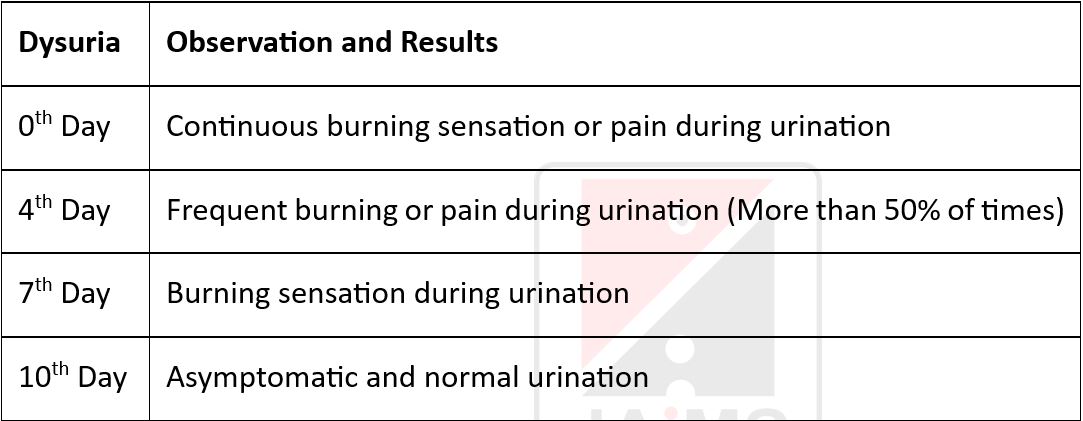To study the effect of Kushmanda Paneeya Kshara in Mutrakrichra w.s.r. to Urinary Tract Infection - A Case Report
DOI:
https://doi.org/10.21760/jaims.10.9.39Keywords:
Mutrakrichra, Urinary Tract Infection, Kushmanda Kshara, Paneeya KsharaAbstract
Urinary Tract Infection (UTI) is the third most common infection affecting populations globally. In Ayurvedic literature, Mutrakrichra (Urinary Tract Infection) is described as a disease presenting with symptoms akin to Urinary Tract Infection. Kushmanda Paneeya Kshara, an alkaline preparation mentioned in classical Ayurvedic texts, is known for its Tridoshaghna, Deepana, and Pachana properties and is indicated in the management of Mutrakrichra (Urinary Tract Infection). Aim of this study is to evaluate the efficacy of Kushmanda Paneeya Kshara in the management of Mutrakrichra (Urinary Tract Infection). A 70-year-old male patient presented with complaints of dysuria, urgency and difficulty in micturition. Following thorough Ayurvedic assessment through Dasha Vidha Pariksha and modern diagnostic criteria, the patient was diagnosed with Mutrakrichra (Urinary Tract Infection). He was administered Kushmanda Paneeya Kshara at a dose of 250 mg twice daily after meals for 10 days. Clinical assessment was conducted using the Dysuria Discomfort Scale and King’s Health Questionnaire (KHQ), alongside routine urine analysis before and after the treatment. Significant clinical improvement was observed during the treatment course. Dysuria reduced progressively, with the patient becoming asymptomatic by the 10th day. Urinary frequency normalized, and sleep disturbances resolved. Urine analysis revealed a reduction in pus cells from 30-35/hpf to 1-2/hpf. No adverse effects were reported during the study period. Kushmanda Paneeya Kshara proved to be effective in the management of Mutrakrichra (Urinary Tract Infection), providing significant symptomatic relief and improved quality of life. Its diuretic, cooling, and anti-inflammatory actions likely contribute to its therapeutic efficacy, supporting its application in routine clinical practice for similar presentations.
Downloads
References
Najar MS, Saldanha CL, Banday KA. Approach to urinary tract infections. Indian J Nephrol. 2009 Oct;19(4):129.
Satoskar RS, Rege NN, Bhandarkar SD. Pharmacology and Pharmacotherapeutics. 25th ed. New Delhi: Elsevier India; 2017. p. 731.
Sharma PV. Sushruta Samhita: with English translation of text and Dalhana’s commentary along with critical notes. Varanasi: Chaukhambha Vishwabharati; 2010. Uttara Tantra. Mutrakrichra Pratishedha. p. 579–83.
Angadi R. Rasa Tarangini: Ayurveda pharmaceutics and Indian alchemy of Sri Sadananda Sarma with transcendence descriptive English commentary. Varanasi: Chaukhambha Surbharati Prakashan; 2015. p. 229.
Sharma PV. Sushruta Samhita: with English translation of text and Dalhana’s commentary along with critical notes. Varanasi: Chaukhambha Vishwabharati; 2010. Sutra Sthana. Ksharapakavidhi Adhyaya. p. 113–15.
Murthy SKR. Vagbhata’s Ashtanga Hridayam: text, English translation, notes, appendix, and indices. Varanasi: Krishnadas Academy; 2013. Chikitsa Sthana. Mutraghata Chikitsa. p. 373.
Clayson D, Wild D, Doll H, Keating K, Gondek K. Validation of a patient-administered questionnaire to measure the severity and bothersomeness of lower urinary tract symptoms in uncomplicated urinary tract infection (UTI): the UTI Symptom Assessment questionnaire. BJU Int. 2005;96(3):350–9. doi:10.1111/j.1464-410X.2005.05630.x

Published
How to Cite
Issue
Section
License
Copyright (c) 2025 Pranil R. Gawali, Nita M. Kedar

This work is licensed under a Creative Commons Attribution 4.0 International License.














